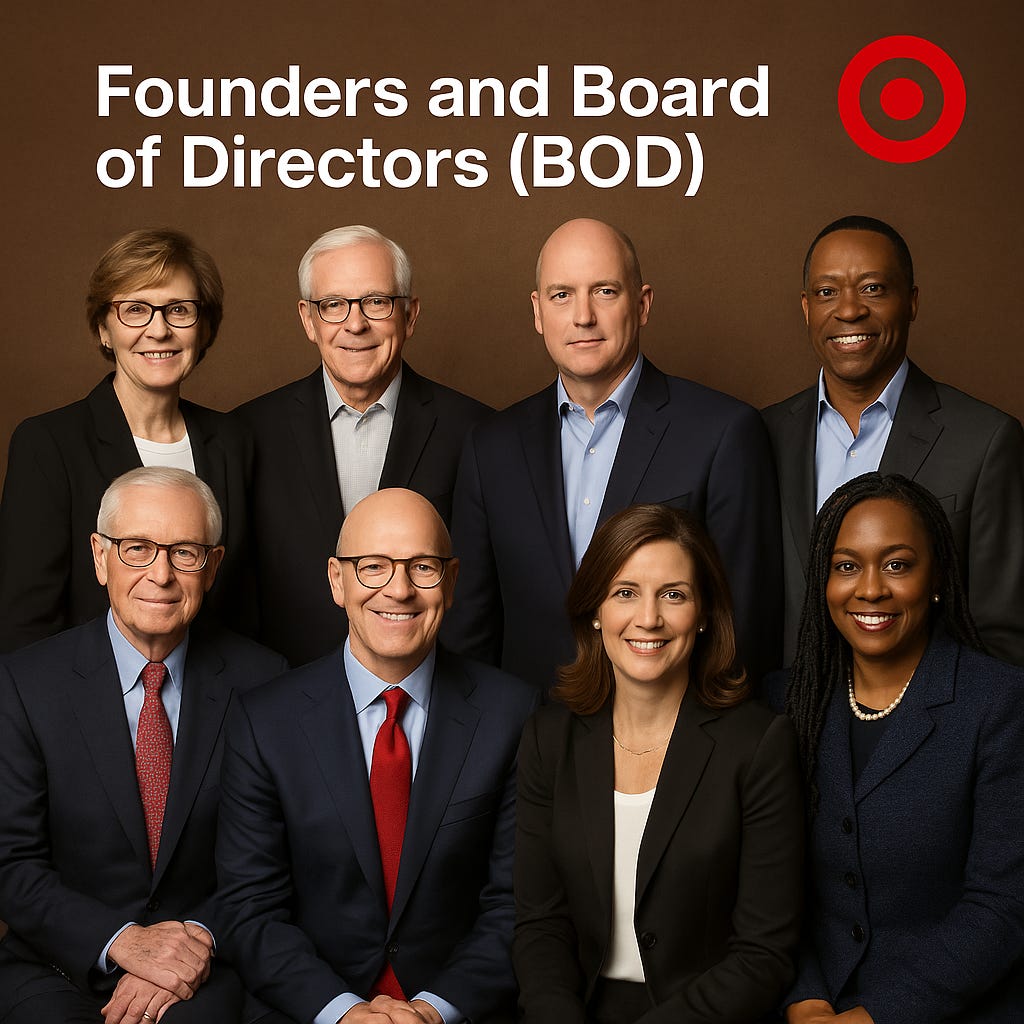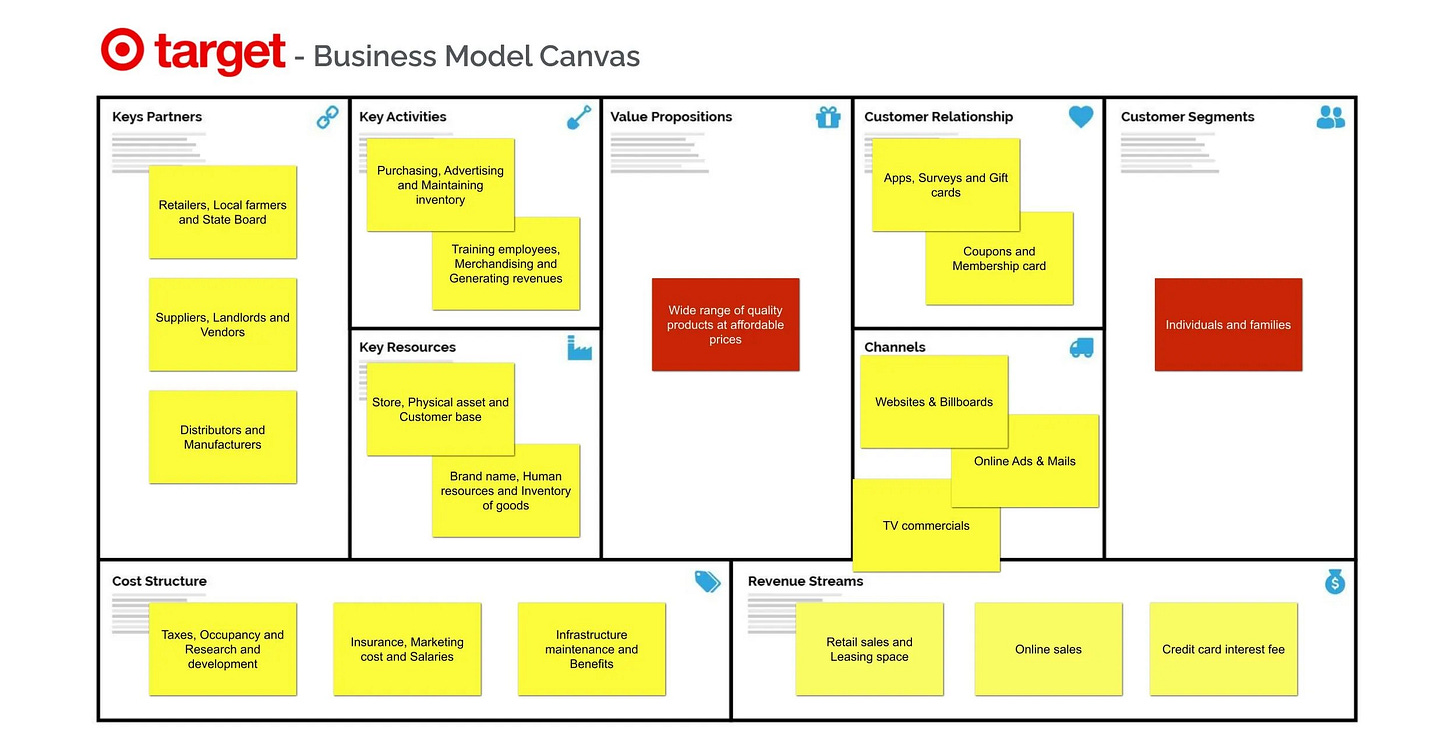Welcome to my unique weekly article for the paid subscriber-only edition.
Outlines and Key Takeaways
Introduction
Founders and Board of Directors (BOD)
Background and History
Business Model
Unique Selling Proposition (USP)
Segmentation, Targeting, Positioning (STP)
What’s Next?
Lessons Learned and Conclusions
Introduction
When it comes to combining style, scale, and seamless retail experiences, Target hits the mark. Known for its bold branding, affordable fashion, and customer-friendly innovation, Target has built a loyal following and a multibillion-dollar empire by being more than just a store—it’s a brand experience.
👥 Founders and Board of Directors (BOD)
Target traces its roots back to 1902, founded by George Dayton in Minneapolis, Minnesota. Originally a department store called Dayton Dry Goods Company, the first Target discount store opened in 1962 as a more modern retail concept.
Today, Target is led by CEO Brian Cornell, who has helped drive digital transformation and bold brand partnerships. Its Board of Directors includes seasoned leaders from tech, retail, and finance—ensuring Target stays competitive and customer-focused in a rapidly shifting market.
🕰️ Background and History
From its humble beginnings, Target has grown into one of the most recognizable retail brands in America, operating over 1,900 stores and employing more than 400,000 team members.
Over the decades, it’s stayed relevant by embracing change—from launching exclusive designer collections to pioneering store formats and early e-commerce innovation. Target’s signature red bullseye has become a symbol of reliability, style, and smart shopping.
💼 Business Model
Target’s business model blends mass-market accessibility with curated retail experiences. Key components include:
✅ Private Label Power – Brands like Up&Up, Cat & Jack, Goodfellow & Co., and Threshold drive high margins and brand loyalty.
✅ Omnichannel Strategy – Seamless integration of in-store, curbside pickup, mobile app, and delivery via Shipt.
✅ Store-as-Hub – Target’s stores double as mini-fulfillment centers, enabling faster, cheaper order processing and delivery.
✅ Data-Driven Inventory – AI and analytics guide stocking decisions and personalized promotions.
⭐ Unique Selling Proposition (USP)
Target is positioned as a stylish, affordable, and easy-to-shop destination where customers don’t have to choose between price and design.
Its stores are known for clean layouts, curated endcaps, seasonal experiences, and well-lit aisles—making shopping feel elevated without being expensive. Add to that its consistent value and friendly staff, and you get a truly differentiated experience.
🧩 Segmentation, Targeting, Positioning (STP)
Segmentation: Young families, millennials, suburban shoppers, budget-conscious yet brand-aware consumers.
Targeting: Consumers who appreciate both value and style—those looking for more than just savings.
Positioning: “Expect More. Pay Less.”
Target’s in-house design teams help create stylish products that look premium but remain affordable, attracting shoppers who value both price and aesthetics.
🔮 What’s Next?
Target is investing in:
🚀 Sustainability – Greener stores, recyclable packaging, and net-zero emissions by 2040.
📱 App Innovation – Personalized deals, AI-driven recommendations, and faster mobile checkout.
🏬 Small Format Stores – Opening compact urban locations to serve dense, fast-paced markets.
💡 Loyalty Programs – Expanding Target Circle and integrating with payment and rewards systems for personalized perks.
🤝 Strategic Collaborations – Partnerships with Ulta Beauty, Levi’s, and Apple for in-store brand extensions.
📚 Lessons Learned and Conclusions
✅ Design Matters – Beautiful, functional design isn't just for luxury brands.
✅ Private Labels = Power – Owning your own brands builds margin and customer loyalty.
✅ Omnichannel is Essential – Blending physical and digital touchpoints enhances convenience and retention.
✅ Culture Wins – Target’s team-oriented, guest-first culture ensures consistent service across thousands of locations.
✅ Stay True, But Evolve – Target has remained recognizable while adapting rapidly to new shopper behaviors.
💬 Final Thought
Target proves that mass retail can be done with intention, creativity, and care. By balancing scale with personalization and staying ahead of consumer trends, Target has become not just a place to shop—but a brand people love.
📅 Don’t miss the Target feature in our BizDecoded Live Series.
BIZDECODED - behind the brand - inside the money machine
🚨 Don’t Miss Out – Register Now
📍 Live Sessions Every Wednesday + Saturday
🕚 11:00 AM CST | Starting August 2025
🎥 Real brands. Real lessons. Real business transformation
🎟️ Full Access: $799
🎟️ Loyal Fans: $50 discount
🎟️ AMA Roadtrip Alumni: $100 discount
📽️ Recap Only: $399 (recordings + articles)
🚀 Register Now – Early Bird Discount Ends Soon!
Seats are limited for the live experience.
Sign up today to lock in the $599 early bird rate and secure your front-row seat to 20 powerful sessions with DBA John Ngo – a rare voice of authority who combines theory, action, and field expertise like no one else.
This is where brands are decoded.
This is how you level up.
Welcome to BizDecoded: Behind the Brand – Inside the Money Machine.
Exclusively on BizInsider.
🔗 Reserve your spot now – these are the brand insights you can’t Google.
👉 Join the program now!
#BizInsider #BizDecoded #TargetStrategy #RetailLeadership #BrandExperience #PrivateLabelSuccess #OmnichannelRetail #FranchiseInsight #JohnNgo #BehindTheBrand #ExpectMorePayLess









